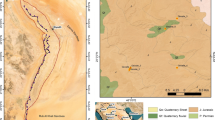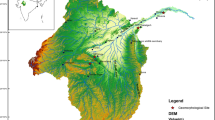Abstract
The standard for the selection of two fourth order watersheds for intensive geomorphic study was extremity in basin-area to assess diversity in between two watersheds in regard to their geomorphic environment. The diversity in geological traits reveals that the Phalal watershed was characterized by contact zone of two lithological formations (Augun gneiss 95% and Rautgara quartzites 5%) separated by north Almora thrust (NAT) while the entire Siya watershed was developed only in one formation, i.e. Rautgara (quartzites) Formation. The diversity in geomorphometric personality and geomorphic evolution speaks of a differential development of both watersheds in context of stage of erosion. The zone of critical-height above which the erosion is acute is 1700 to 1800 m in Phalal watershed, whereas 1500 to 1600 m in Siya watershed; the hypsometric integral determines Phalal watershed (49.96 %) under middle-mature stage while Siya watershed (57.07 %) achieved early-mature stage. Diversity in erosion status was observed along the varying altitudes of the watersheds under different land use/cover. Diversity in the spatial distribution of altitude, erosion intensity, average slope versus land use/cover status under both watersheds determines the impact of basin-area extremity. The hazardous geomorphic processes also indicate the impact of basin-area extremity as eleven types of geomorphic hazards were experienced by the Phalal watershed while only four types of hazards were experienced by Siya watershed. Phalal watershed was 18.42 % hazardous area while 21.04 % hazardous area was possessed by Siya watershed. The hazard of ‘surficial erosion’ covers maximum area, i.e. 13.78 % in Phalal watershed while 20.52 % area is possessed by Siya watershed. Likewise maximum study units attained degree 4 instability for Phalal watershed (80%) while degree 2 instability for Siya (50%) watershed. Thus, basin-area has direct posture on geological traits, geomorphic evolution, geomorphometric personality and hazardous geomorphic processes while land use/cover status has no bearing on basin-area extremity under the studied watersheds.
Similar content being viewed by others
References
Anderson, H.W. (1957) Relating sediment yield to watershed variable. Trans. Amer. Geophys. Union, v.38, pp.921–4.
Benito-Calvo, A., Perez-Gonzalez, A., Magri, O. and Meza, P. (2009) Assessing regional geodiversity: The Iberian Peninsula. Earth Surface Processes and Landforms, v.34(10), pp.1433–1445.
Dixon, G. (1995) Geoconservation: an international review and strategy for Tasmania; a report to the Australian Heritage Commission, Occasional Paper No. 35, Parks and Wildlife Service, Tasmania.
Gray, M. (2004) Geodiversity: valuing and conserving abiotic nature. Chichester: John Wiley and Sons.
Hjort, J. and Luoto, M. (2010) Geodiversity of high-latitude landscapes in northern Finland. Geomorphology, v.115, pp.109–116.
Kienholz, H., Schneider, G., Bischel, M., Grunder, M. and Mool, P. (1984) Mapping of mountain hazards and slope stability. Mountain Research and Development, v.4(3), pp.247–266.
Strahler, A.N. (1952) Hypsometric (area-altitude) analysis of erosional topography. Bull. Geol. Soc. Amer., v.63, pp.117–1142.
Kiernan, K. (1996) Conserving geodiversity and geoheritage: the conservation of glacial landforms; Report to the Australian Heritage Commission.
Kiernan K. (1997) The conservation of landforms of coastal origin: conserving Tasmania’s geodiversity and geoheritage: forest practices unit, Hobart, Tasmania, 273p.
Kot, R. (2018) A comparison of results from geomorphological diversity evaluation methods in the Polish Lowland (Toruñ Basin and Che3mno Lakeland). Geography, v.118 (1), pp.17–35, DOI:https://doi.org/10.1080/00167223.2017.1343673
Kozlowski, S. (2004) Geodiversity. The concept and scope of geodiversity. Przeglad Geologiczny, v.52(8/2), pp.833–837.
Melelli L., Vergari F., Liucci L., Del Monte M.(2017) Geomorphodiversity index: Quantifying the diversity of landforms and physical landscape. The Science of the Total Environment, Sci Total Environ. pp. 584–585:701714. doi:https://doi.org/10.1016/j.scitotenv.2017.01.101.
Pande. A. (1998) Geomorphic Hazard Mapping in Jaigan Watershed, Central Himalaya. Unpublished Final Technical Report (March 1995 — February 1998), submitted to Council of Scientific and Industrial Research, New Delhi, India for the award of Senior Research Associateship under Scientists’ Pool Scheme, Award No. 13 (6870-A)/95-Pool,159p.
Pellitero R., González-Amuchastegui M.J., Ruiz-Flaño, P., Serrano, E. (2011) Geodiversity and geomorphosite assessment applied to a natural protected area: the Ebro and Rudron Gorges Natural Park (Spain). Geoheritage, v.3(3), pp.163–174
Pereira, D.I., Pereira, P., Brilha, J., Santos, L. (2013) Geodiversity assessment of Parana State (Brazil): an innovative approach. Environmental Management, v.52, pp. 541–522.
Ruban, D. (2010) Quantification of geodiversity and its loss. Proceedings of the Geologists’ Association, v.121, pp.326–333.
Serrano, E., Ruiz-Flaño, P. (2007) Geodiversity: a theoretical and applied concept. Geogr. Helv., v.62 (3), pp.140–147
Sharples, C. (1993) A methodology for the identification of significant landforms and geological sites for geoconservation purposes; Report to Forestry Commission, Tasmania
Shrivastava, K.L., Awasthi, I.B. and Trivedi, R.K. (1986) An evaluation of Geomorphology and Geoenvironment of Upper Betwa Basin, Central India. Oikoassay, v.3(1), pp.3–10.
Silva J. P., Pereira D. I., Aguiar A. M. and Rodrigues C. (2013): Geodiversity assessment of the Xingu drainage basin, Jour. Maps, pp.1-9. DOI:https://doi.org/10.1080/17445647.2013.775085
Strahler, A.N. (1964) Quantitative Geomorphology of Drainage Basins and Channel Networks: In Chow, V.T. (Ed.), Hand book of Applied Hydrology, McGraw Hill, New York, pp.4–11.
Valdiya, K.S. (1980) Geology of Kumaun Lesser Himalaya, Wadia Institute of Himalayan Geology, Dehradun, 291p.
Zavoianu I. (1985) Chapter IV Drainage-Basin Area. Part of volume: Morphometry of Drainage Basins, Developments in Water Science, v.20, pp.63–87.
Zwolinski, Z. (2010) The routine of landform geodiversity map design for the Polish Carpathian Mts. Landform Analysis, v.11, pp.77–85.
Author information
Authors and Affiliations
Corresponding author
Rights and permissions
About this article
Cite this article
Pande, A. Appraisal of Geomorphic Diversity with Special Reference to Basin-Area Extremity in Central Lesser Himalaya. J Geol Soc India 94, 375–386 (2019). https://doi.org/10.1007/s12594-019-1325-3
Received:
Accepted:
Published:
Issue Date:
DOI: https://doi.org/10.1007/s12594-019-1325-3




